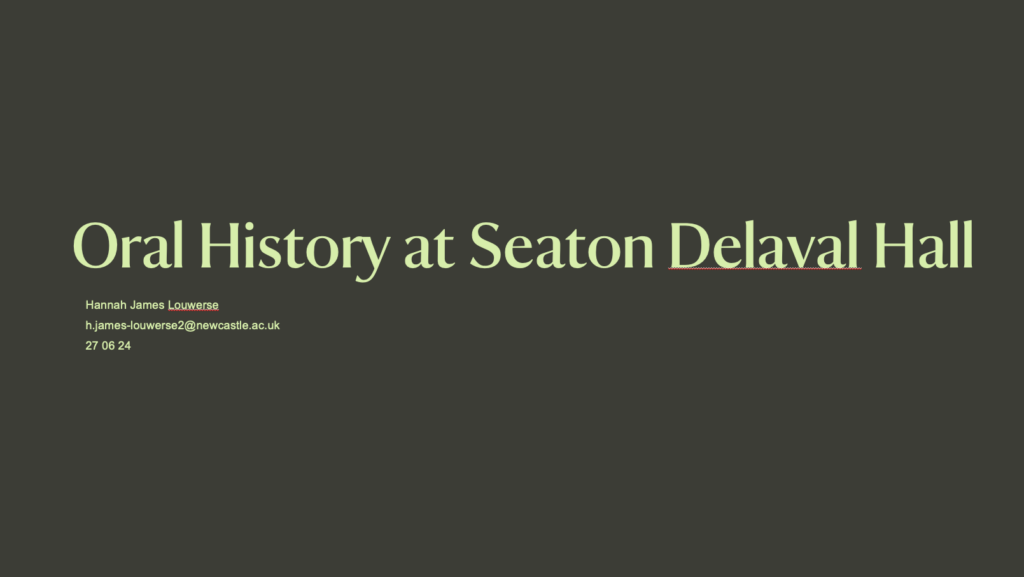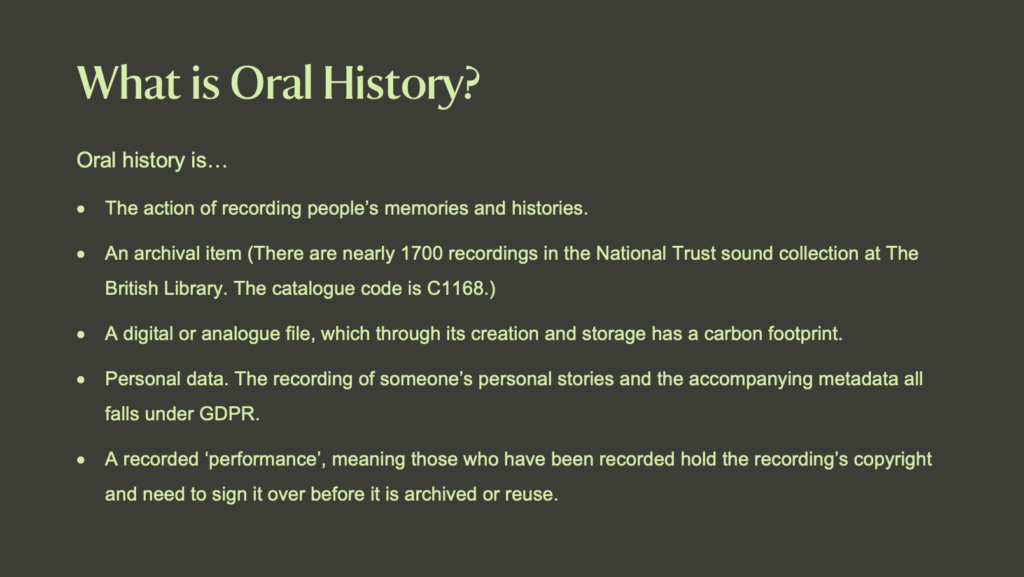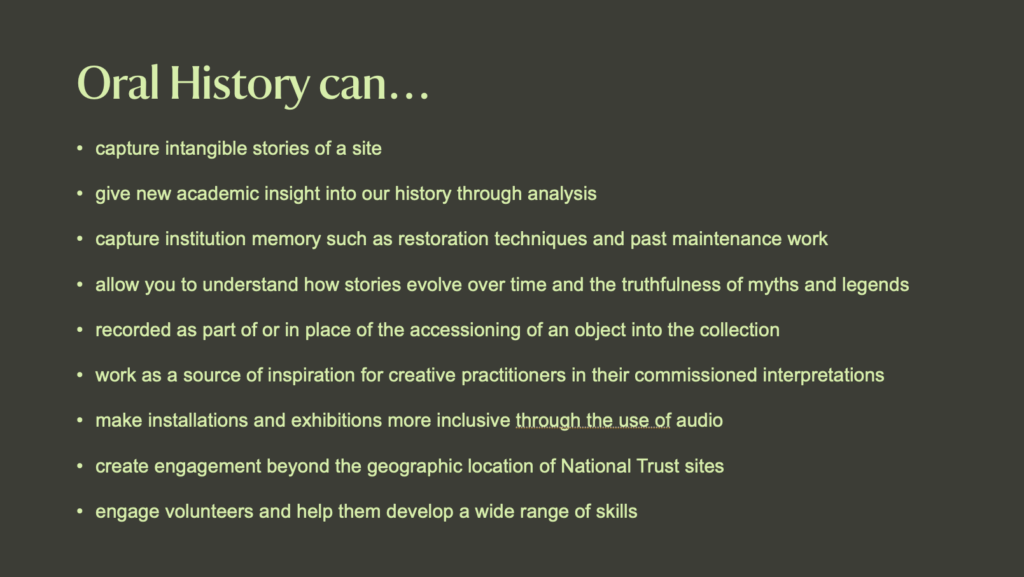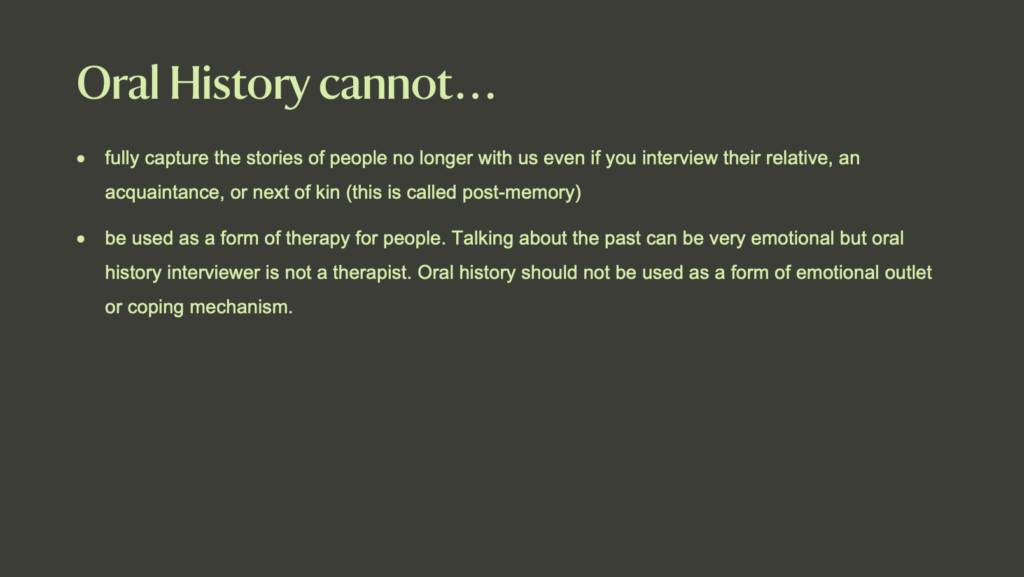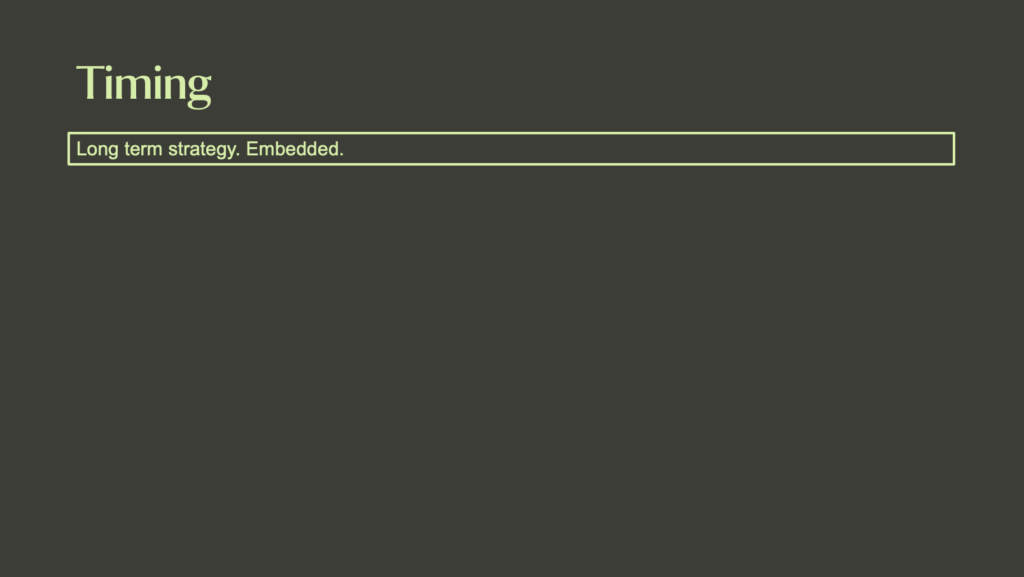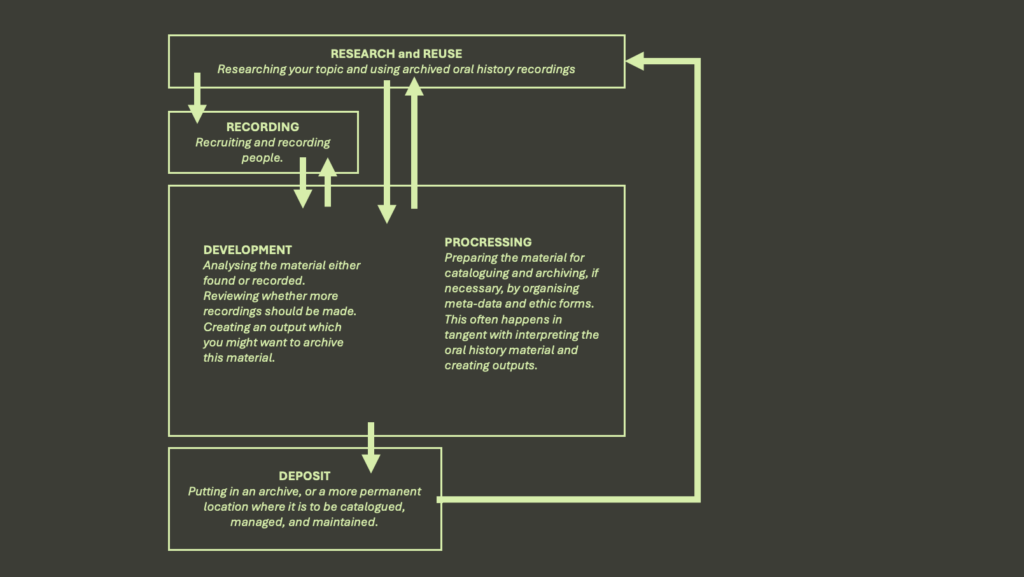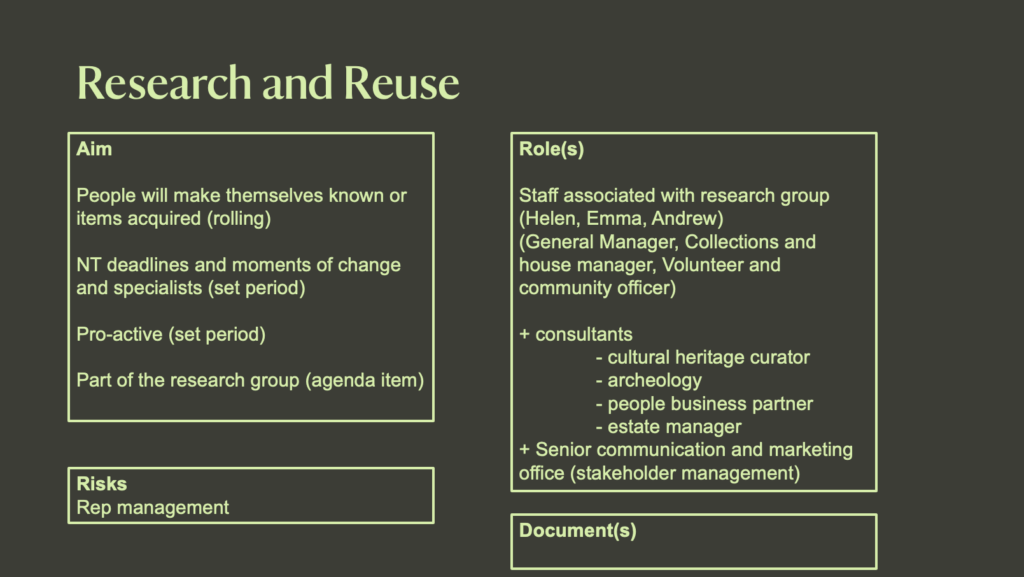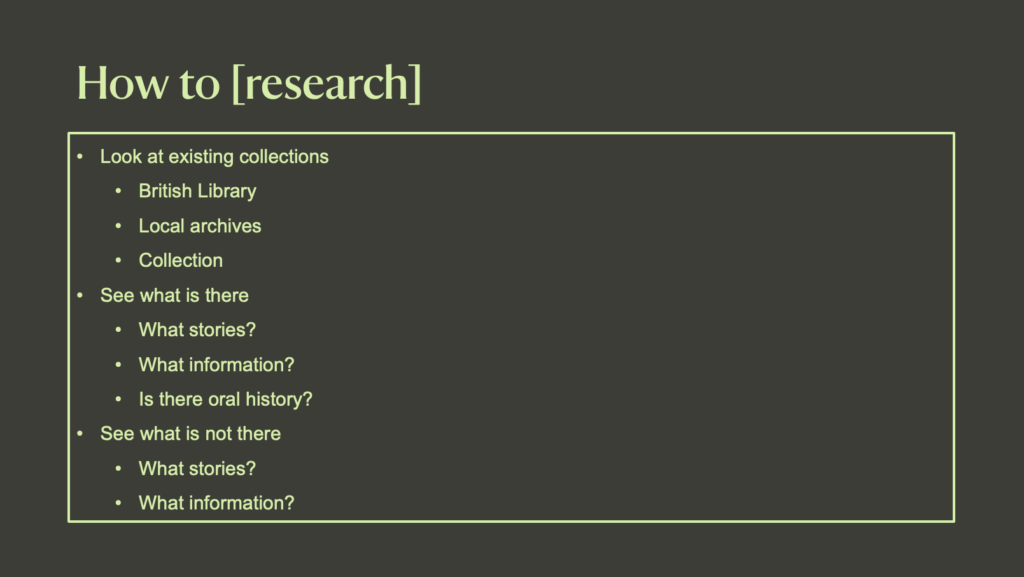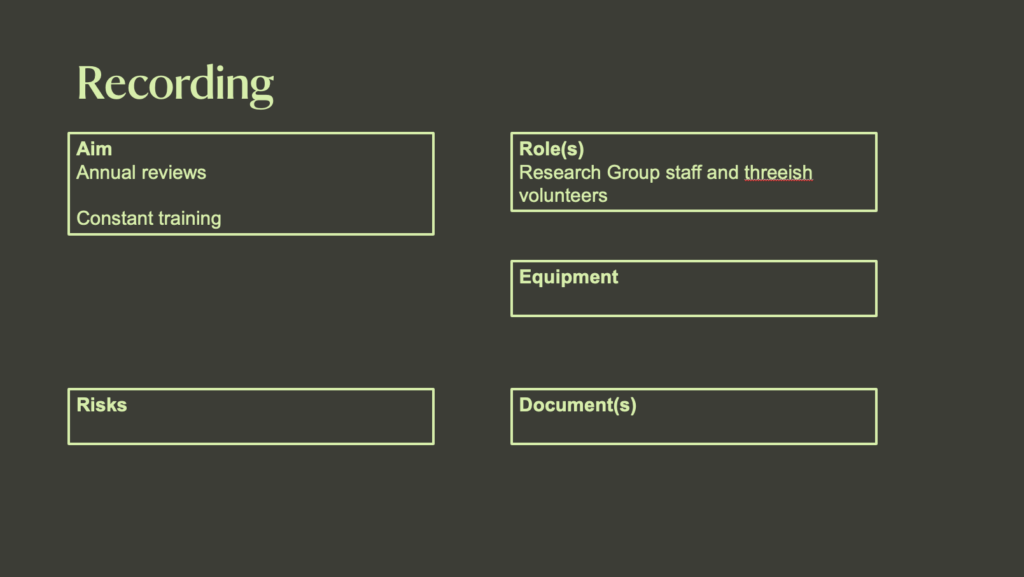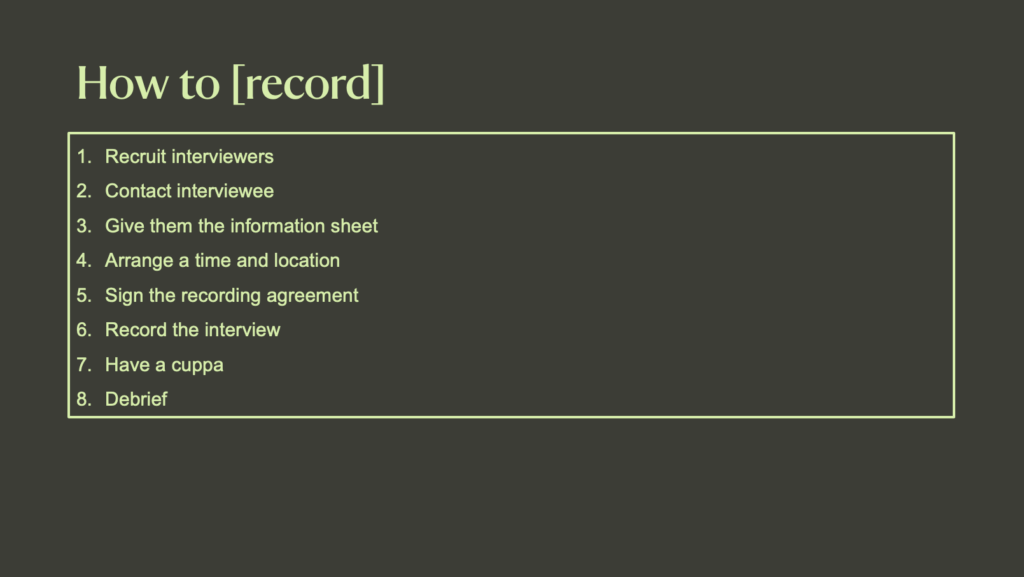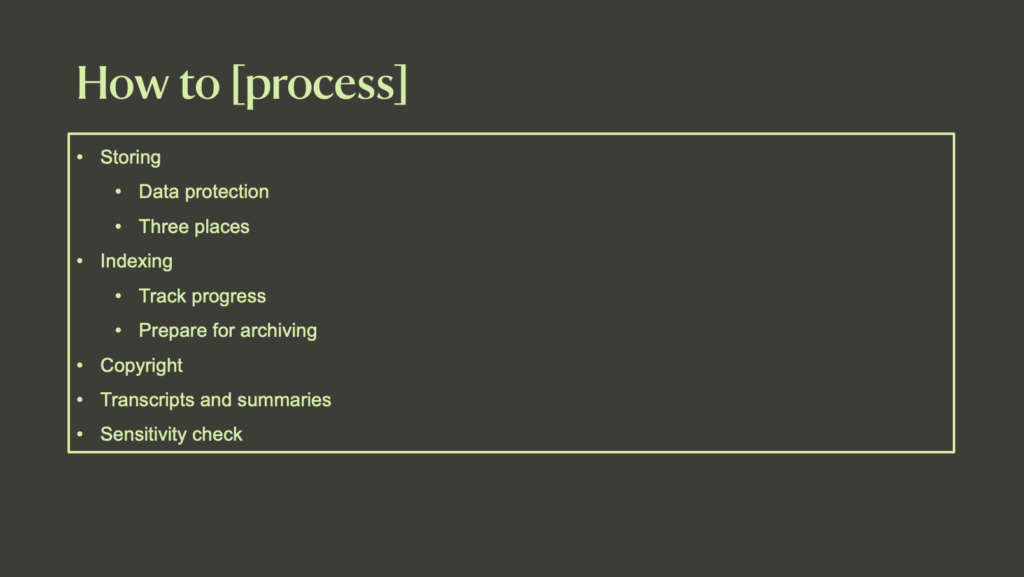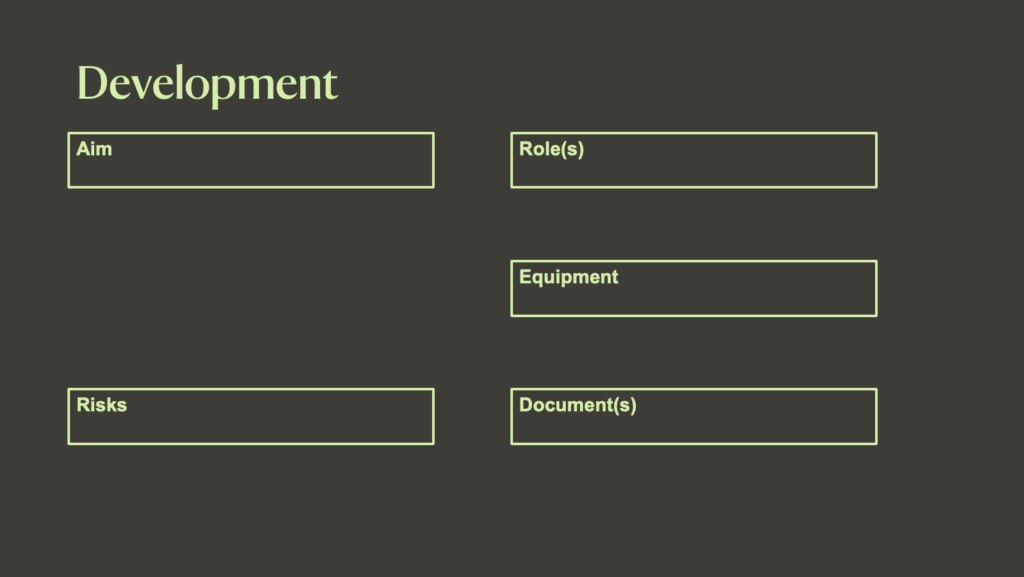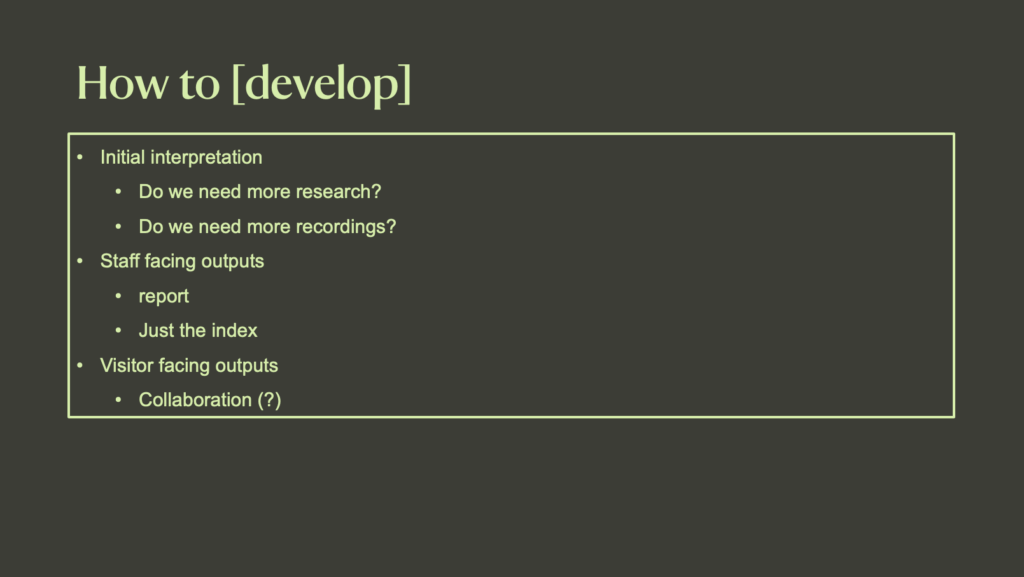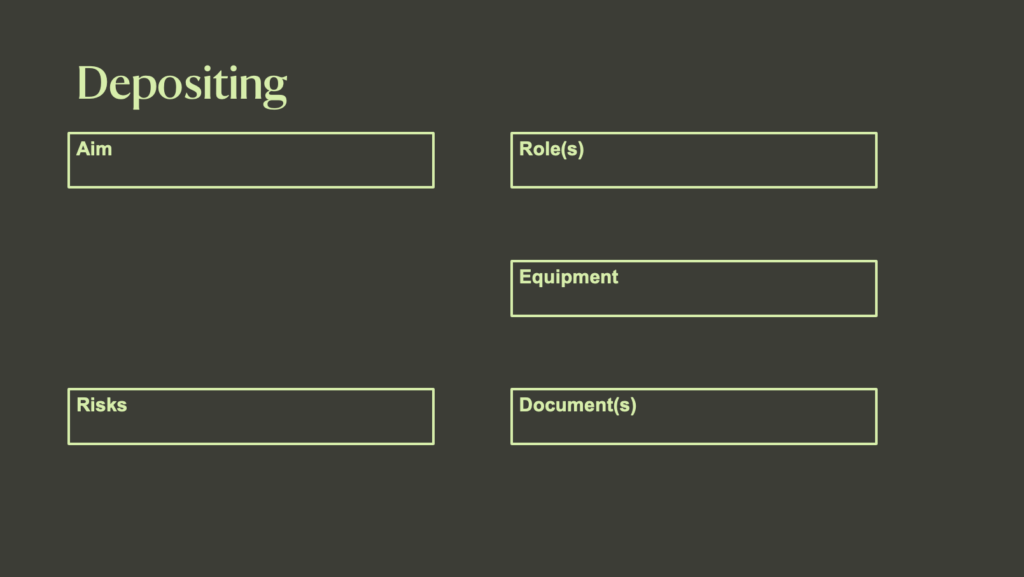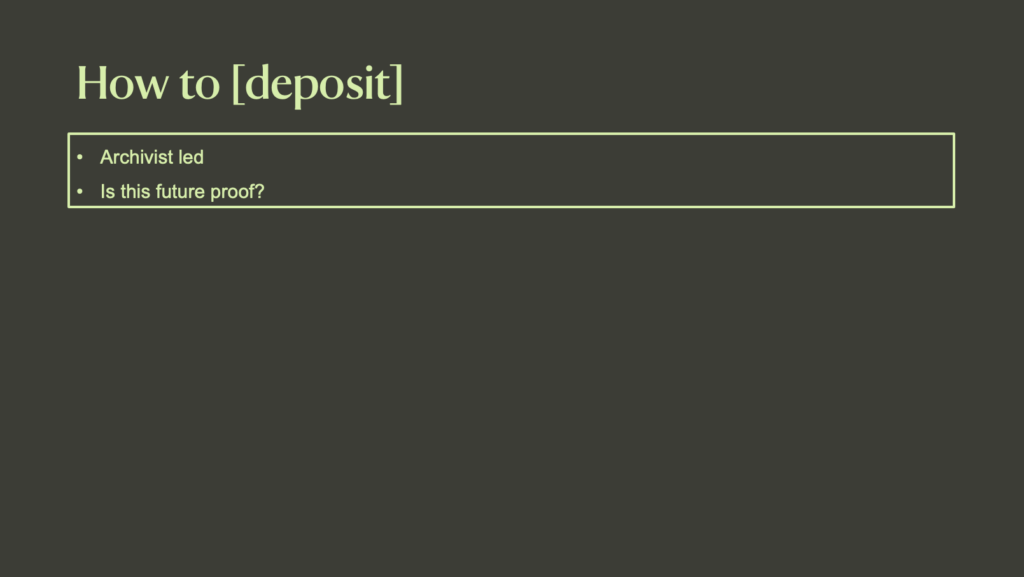Tag Archives: Workshop
OHD_COL_0279 JAN CRIT PLAN ETC
Plan for January conference/crit day – Version One
The day has been split into two halves. The first half will be more orientated towards the National Trust and any other public history institutions, while the second half is more focused on how to innovate and design solutions for maintaining archives. Both sessions will be online and will be recorded. I will also use a virtual whiteboard to document ideas, questions, and thoughts from the participants.
Morning Session – Oral history at the National Trust
Aim:
The general aim of this session to inform participants on the current status of oral history at the National Trust and to get feedback on some of my work which illustrates the various elements of oral history maintenance and see how this may translate over to the collection processes and policy at the National Trust.
Starting activity:
Everyone is asked to write down what they think oral history is.
Part one: Oral history at the National Trust up to now
In the first part of the session we will look at the current situation of oral history at the National Trust, starting with asking the group if anyone has done or has knowledge of any oral history projects done by National Trust sites. This will be followed by me giving brief history of oral history at the National Trust and information on the National Trust sound collection at The British Library. With permission from The British Library I would like to share the spreadsheet I made during my placement and get small groups to explore the catalogue for a couple minutes. We will then end this part of the morning with a quick “brain dump” where any thoughts, questions, ideas are shared with the wider group.
Part two: The future of Oral History at the National Trust
The second part of the sessions starts with me sharing my general breakdown of what is required to maintain an oral history recording. After this the larger group is split into smaller groups again and they are asked to think how this might work within the context of the National Trust. To give the groups a bit of structure they are encouraged to think of the 5 Ws and 1 H questions (Who, What, When, Where, Why, and How), then think how they might answer these questions.
Ending activity:
Everyone is asked again to write down what they think oral history is.
Afternoon Session – Innovation and design in archives
Aim:
The aim of this session is for me to share my experience and ideas of designing in archives.
The group will think about what it means for designers to work in archives but also what we mean by a “successful” or “good” archive.
Starting activity:
Everyone is asked to write down what they think an archive is.
Part One: What we learn from designer in archives?
In the first part of the session the participants are split into smaller groups which are a mixture between archivists and designers. Each group is given a scenario about maintaining access to oral history. They are then asked to think about what they would do in this particular scenario and as a group have to come with a plan. The plans are then shared in the larger group. They then go back into their smaller groups and are asked to think about whether the designers or archivists learnt anything from each other. After the smaller groups feedback again, I briefly talk about my experience of being a designer working in archives, specifically my thoughts on design and maintenance.
Part Two: What is a good archive?
Leading on from my thoughts on maintenance and design, the group is task with critically thinking what success looks like within archives. The group is first asked what they write what they think the value of archives is and are then given another scenario to discuss in their smaller groups. The scenario they are given is a world where everything can be kept and is accessible, all issues around digital obsolescence, copyright and data protection have been solved, but the climate crisis is threatening the stability of the storage systems, decay, and destruction of original material is inevitable. To give the groups some structure they are given a concepts and ideas matrix to sort their thoughts. After coming together as a big group again and feed backing, the whole group is asked whether the ideas and concepts they came up with reflect what they believe the value of archival material is.
Ending activity:
Everyone again writes what they think an archive is.
Version 2
Introduction to my PhD (General) – 15 mins
Story of the current collection PLUS values – 10 mins
Q and A – 5 mins to 10 mins
What value can oral history recordings give to the collections on sites? – 20 mins
Feedback – 10 mins
—————————————————— BREAK 5 mins
Issues with archiving and storing of OH at NT – 10 mins
Q and A – 5 mins to 10 mins
What resources do we need to make the flow from recording to archived easier? – 20 mins
Feedback – 10 mins
________________________________________ BREAK 5 mins
Legacy and knowledge transfer – 5 mins
Q and A – 5 mins to 10 mins
How do we make it easier to reuse oral history recordings? – 20 mins
Feedback – 10 mins
__________________________
Wrap up and thanks – 10 mins
Close
Workshop Blurb
A look into Oral History at the National Trust
Wednesday 31st Jan 2024
14:00 – 17:00
Online
This workshop is a culmination of three years of research into the past, present, and future of Oral History at the National Trust. It will take you through the stories found in the sound collection of 1700 recordings archived at The British Library, and the experience of recording Oral History on a National Trust site today. It will also offer insight into the opportunities and obstacles of recording future Oral History at the National Trust. The workshop aims to create a discourse around the rich, yet awkward resource of Oral History, how it can enrich the stories told by the National Trust, and the practical side of recording, archiving, and using such a personal artefact.
Hannah James Louwerse is completing her Collaborative Doctoral Award at Newcastle University. Her project is partnered with Seaton Delaval Hall where she has recorded oral histories from the community. She also completed a placement at The British Library auditing the National Trust’s large sound collection.
OHD_WHB_0247 Miro board of the NCBS away day
OHD_WKS_0204 THINKING CARDS: How would you archive this?

How would you archive this?
– a interview that is closed off for 30 years but is digital
– with transcript
– with photographs analogue
– about gender
– about race
How would you access this?
TASK:
Start conversations around how we archive things
AIM:
Collect experts’ opinions on strange archiving situation
TYPES OF CARDS
ARCHIVE
– KGB archive
– British Library
– https://www.alternativetoronto.ca/archive/about
– https://creativememory.org/en/archives/
– TWAM
– Black archive
ARCHIVE ITEM
– A wax cylinder recording of an aboriginal voice
– Australian housewives
– Sex workers
– Transperson
– UN oral history
– Lady at the races
– The Edwardians
– With photographs
CHANGE
– Terrorism
– Fire
– Flood
– Earthquake
– Malware
– Ethnic cleansing
–
fire, accidental
fire, arson
flooding, from outside flooding, from inside earthquake
other ‘natural causes’
armed conflict
removed by occupying forces civil disorder
terrorism
inherent instability
bacteria, insects and rodents mould and humidity
dust
pollution
bad storage
lack of restoration capacity bad restoration
neglect
while moving offices administrative order unauthorised destruction theft
use
INTERPRETERS
– Podcasters
– Journalist
– Artist
– Writers
– Film makers
– Creators
– Investigators
– Historians
– Family
– People in search of identity
OHD_MDM_0159 Design Manifesto Mindmap
OHD_WKS_0131 Break the Archive
My first workshop with strangers! It was called Break the Archive and it was really fun but too short. You can download my report below.
OHD_WKS_0129 Creating Space for Voice
Miro Board
A link to the workshop Miro Board
Workshop Plan
In this workshop the participants will be asked to reflect on which spaces restrict or elevate voice and what elements, methods, or tactics are used to make these spaces. They will be challenged to turn to archives and question how this space handles voice and what it could learn from other spaces. It is a workshop where no idea is a bad idea, and thinking outside of the box is a must.
All of the activities will be using a miro board to capture what is being said and explored.
Intro (2 mins)
I will very briefly introduce myself, my project and what we are going to do in the workshop.
Activity One: What is an archive? (10 mins)
Aim: To break down the symbols and language of the archive
Task: The participants will be deconstruct the archive through the five senses. What doing they see, smell, hear, feel, and taste when they are in an archive or think of when they hear the word ‘archive’?
Activity Two: The Scale of Voice (10 mins)
Aim: To map different spaces on a scale of suppressing the voice to elevating the voice and identifying where people feel they are most listened to
Task: The participants will be asked to think of the spaces where they feel their voice heard and where they feel their voice is suppressed. Hopefully, spaces from museums to dinner tables to secondary school classrooms to Twitter will be mapped along a scale, which in the end will show us where people feel most comfortable to speak.
Activity Three: What are these spaces? (10 mins)
Aim: To break down the symbols and language of the spaces where the participants feel their voice is most elevated
Task: Just like the first task the participants will deconstruct the space where they feel the most listened to through the five senses. What doing they see, smell, hear, feel, and taste when they are in these spaces? Depending on the number of people participating each space can be tackled consecutively if there are not many participants or in break out rooms where each rooms breaks down a different space.
Activity Four: What now archive? (15 mins)
Aim: To generate ideas and concepts that could transform the archive into a space more like those where people feel heard
Task: The participants will be invited to compare and contrast the experiences of archives and the spaces dissected in the previous activity, and use this as inspiration to create concepts and ideas that could make archives into a more voice friendly space.
Final thoughts (What ever time is left)
At this point people can ask questions, add any additional thoughts and ideas to the miro board, and generally reflect on the workshop as a whole.
OHD_BLG_0043 Philosophy is easier than reality
On Monday 11th April 2022 I attended and ran a workshop at the Seaton Delaval Hall Community Research Day. It was an exceptionally interesting affair and mostly certain did not go the way I imagined. If I had to sum it up I would describe it as engaging but impractical. To say that it got deep real quick would be an understatement but the to which it went was fascinating. It was also great to just bounce ideas off people. However it felt like whenever I attempt to move the conversation to getting to more practical solutions people rather stayed in philosophical and imaginary realm or they would just explain why it would not be possible to change that.
Maybe I am too much of a designer, wanting to think of solutions instead of sticking to the status quo. Or maybe this is exactly what I should be doing, building a bridge between the imaginary realm and the real world. Maybe this is the point that Verganti talks about when he discusses ‘Interpreters’. The people in that room on Monday were my interpreters, the people I can draw on for inspiration and ideas…
If this is the case it is now my job to turn the “multi-verse” of history that we kept talking about into reality. No pressure….
